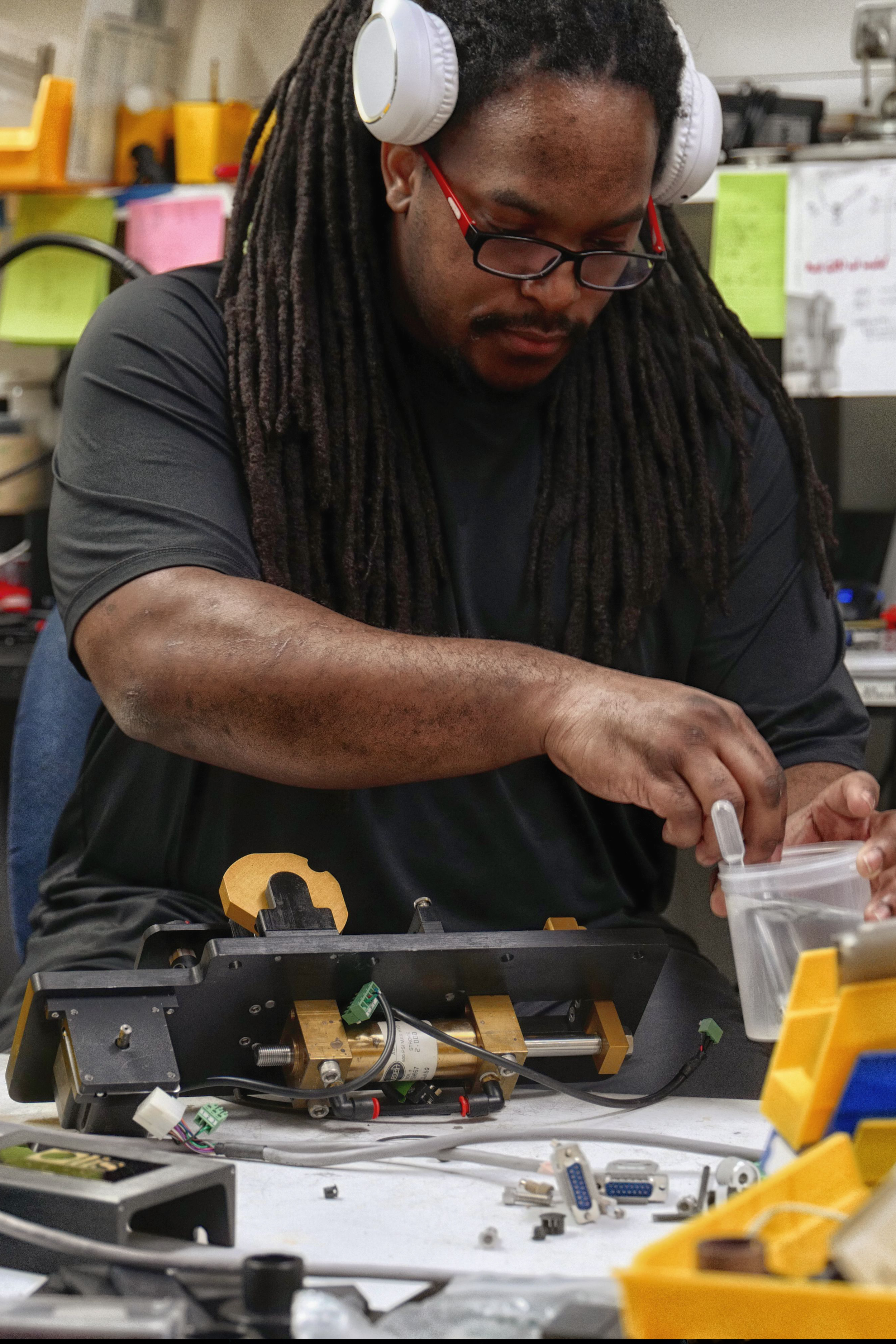About Uv/vis/nir
About Uv/vis/nir
Blog Article
The 8-Minute Rule for Uv/vis
Table of ContentsGet This Report about SpectrophotometersAn Unbiased View of Circularly Polarized LuminescenceUv/vis Can Be Fun For AnyoneUv/vis/nir for Dummies7 Simple Techniques For Uv/visFacts About Circularly Polarized Luminescence RevealedThe Of SpectrophotometersAll About Circularly Polarized LuminescenceUv/vis/nir Can Be Fun For AnyoneHow Circular Dichroism can Save You Time, Stress, and Money.Get This Report on SpectrophotometersNot known Details About Circular Dichroism Circularly Polarized Luminescence Fundamentals Explained
It is then scanned through the sample and the referral solutions. Portions of the event wavelengths are transmitted through, or reflected from, the sample and the referral. Electronic circuits convert the relative currents into linear transmission portions and/or absorbance/concentration worths.The transmission of a referral compound is set as a standard (datum) worth, so the transmission of all other compounds are recorded relative to the preliminary "zeroed" compound. The spectrophotometer then transforms the transmission ratio into 'absorbency', the concentration of particular components of the test sample relative to the preliminary substance.
Considering that samples in these applications are not readily offered in big quantities, they are specifically suited to being evaluated in this non-destructive technique. In addition, valuable sample can be saved by making use of a micro-volume platform where as low as 1u, L of sample is needed for total analyses. A short explanation of the procedure of spectrophotometry includes comparing the absorbency of a blank sample that does not contain a colored substance to a sample which contains a colored substance.
3 Easy Facts About Uv/vis/nir Described
In biochemical experiments, a chemical and/or physical residential or commercial property is chosen and the procedure that is utilized specifies to that home in order to derive more details about the sample, such as the amount, purity, enzyme activity, and so on. Spectrophotometry can be utilized for a number of strategies such as identifying optimal wavelength absorbance of samples, determining ideal p, H for absorbance of samples, figuring out concentrations of unidentified samples, and figuring out the p, Ka of different samples.: 21119 Spectrophotometry is also a practical procedure for protein purification and can likewise be used as a method to develop optical assays of a substance.
It is possible to know the concentrations of a 2 component mixture utilizing the absorption spectra of the basic solutions of each part. To do this, it is needed to know the extinction coefficient of this mix at 2 wave lengths and the extinction coefficients of options which contain the known weights of the 2 elements.

Our Spectrophotometers Diaries
Region. The concentration of a protein can be estimated by determining the OD at 280 nm due to the existence of tryptophan, tyrosine and phenylalanine.
Nucleic acid contamination can also interfere. This method needs a spectrophotometer efficient in determining in the UV area with quartz cuvettes.: 135 Ultraviolet-visible (UV-vis) spectroscopy includes energy levels that delight electronic shifts. Absorption of UV-vis light delights particles that are in ground-states to their excited-states. Noticeable region 400700 nm spectrophotometry is utilized thoroughly in colorimetry science.
20. 8 O.D. Ink manufacturers, printing business, textiles vendors, and much more, need the data supplied through colorimetry. They take readings in the area of every 520 nanometers along the noticeable region, and produce a spectral reflectance curve or an information stream for alternative discussions. These curves can be utilized to evaluate a new batch of colorant to inspect if it makes a match to specs, e.
The Greatest Guide To Uv/vis
Standard noticeable area spectrophotometers can not identify if a colorant or the base product has fluorescence. This can make it tough to manage color issues if for instance several of the printing inks is fluorescent. Where a colorant includes fluorescence, a bi-spectral fluorescent spectrophotometer is used (https://hubpages.com/@olisclarity1). There are two significant setups for visual spectrum spectrophotometers, d/8 (spherical) and 0/45.
Scientists utilize this instrument to measure the quantity of compounds in a sample. If the compound is more concentrated more light will be soaked up by the sample; within small ranges, the Beer, Lambert law holds and the absorbance in between samples differ with concentration linearly. When it comes to printing measurements 2 alternative settings are commonly used- without/with uv filter to manage better the result of uv brighteners within the paper stock.
The Ultimate Guide To Uv/vis/nir
Some applications require little volume measurements which can be performed with micro-volume platforms. As explained in the applications area, spectrophotometry can be utilized in both qualitative and quantitative analysis of DNA, RNA, and proteins. Qualitative analysis can be utilized and spectrophotometers are utilized to tape-record spectra of substances by scanning broad wavelength areas to determine the absorbance residential or commercial properties click reference (the intensity of the color) of the compound at each wavelength.

Circular Dichroism for Beginners
One major element is the kind of photosensors that are available for different spectral regions, but infrared measurement is also difficult because practically everything discharges IR as thermal radiation, especially at wavelengths beyond about 5 m. Another problem is that several products such as glass and plastic take in infrared, making it incompatible as an optical medium.
Samples for IR spectrophotometry may be smeared in between two discs of potassium bromide or ground with potassium bromide and pushed into a pellet. Where liquid services are to be measured, insoluble silver chloride is utilized to construct the cell. Spectroradiometers, which operate nearly like the noticeable area spectrophotometers, are developed to measure the spectral density of illuminants. Obtained Dec 23, 2018. Essential Lab Methods for Biochemistry and Biotechnology (2nd ed.). The vital guide to analytical chemistry.
Chichester, NY: Wiley. pp. 1617. ISBN 9780471974123. OCLC 36543293. Ninfa AJ, Ballou DP (2004 ). Essential lab methods for biochemistry and biotechnology. Hoboken: Wiley. p. 66. ISBN 9781891786006. OCLC 633862582. Rendina G (1976 ). Philadelphia, PA: W. B. Saunders Business. pp. 46-55. ISBN 0721675506. OCLC 147990. Oke, J. B.; Gunn, J. E.
Not known Facts About Circular Dichroism
"Secondary basic stars for outright spectrophotometry". The Astrophysical Journal. 266: 713. Bibcode:1983 Ap, J..266..713 O. doi:10. 1086/160817. Ishani, G (2006 ). "The very first business UV-vis spectrophotometer". p. 100. Obtained Dec 23, 2018. Simoni, RD; Hill, RL; Vaughan, M; Tabor, H (Dec 5, 2003). "A Classic Instrument: The Beckman DU Spectrophotometer and Its Creator, Arnold O.
278 (49 ): e1. doi:. ISSN 1083-351X. Beckman, A. O.; Gallaway, W. S.; Kaye, W.; Ulrich, W. F. (March 1977). "History of spectrophotometry at Beckman Instruments, Inc". Analytical Chemistry. 49 (3 ): 280A300A. doi:10. 1021/ac50011a001. "Hewlett Packard: Substance Recognition with HP 8450 A UV Noticeable Spectrophotometer". Analytical Chemistry. 51 (12 ): 1188A1189A. 1979-10-01.
Ninfa AJ, Ballou DP, Benore M (2015 ). Basic Lab Methods for Biochemistry and Biotechnology (3, rev. ed.). spectrophotometers. Lab Devices.
Spectrophotometers Things To Know Before You Get This
"Applied Spectrophotometry: Analysis of a Biochemical Mixture". Biochemistry and Molecular Biology Education. Journal of Biochemistry Education.
Examine This Report about Uv/vis/nir
U.S. Department of Commerce National Bureau of Standards unique publication; 378. Washington, D.C.: U.S. National Bureau of Standards. p. 2. OCLC 920079.
The procedure begins with a controlled light that brightens the examined sample. When it comes to reflection, as this light connects with the sample, some is absorbed or discharged. The given off light journeys to the detector, which is evaluated, quantified, and presented as industry-standard color scales and indices.
All terms are evaluated over the visible spectrum from 400 to 700 nm. In the case of transmission, when the light communicates with the sample, it is either absorbed, reflected, or transmitted.
Uv/vis/nir Things To Know Before You Get This
Examples consist of APHA (American Public Health Association) for watercolor and purity analysis, ASTM D1500 for petrochemical color analysis, edible oil indices utilized in food, and color analyses of beverages. All terms are evaluated over the visible spectrum from 400 to 700 nm.
Image Credit: Matej Kastelic/ Dr. Arnold J. Beckman and his associates at the National Technologies Laboratories initially developed the spectrophotometer in 1940. In 1935 Beckman founded the business, and the discovery of the spectrophotometer was their most ground-breaking creation.
Examine This Report on Uv/vis
99% precision. With time, researchers kept improving the spectrophotometer style to boost its efficiency. The UV abilities of the model B spectrophotometer were improved by changing the glass prism with a quartz prism. Ultimately, the Model DU was produced, containing a hydrogen light and other enhancements. This instrument was used in industrial laboratories, centers, and chemistry and biochemistry departments.
Generally, a spectrophotometer is made up of 2 instruments, specifically, a spectrometer and a photometer. A fundamental spectrophotometer includes a light source, a monochromator, a collimator for straight light beam transmission, a cuvette to position a sample, and a photoelectric detector.
Spectrophotometers Fundamentals Explained
There are various types of spectrophotometers in different shapes and sizes, each with its own purpose or performance. A spectrophotometer determines how much light is shown by chemical components. UV/Vis/NIR. It measures the distinction in light strength based on the overall amount of light introduced to a sample and the quantity of beam that passes through the sample solution
As per the instrument's style, the sample is positioned between the spectrometer and the photometer. After the light is gone through the sample, the photometer measures its strength and shows the reading. A spectrophotometer is used to determine the concentration of both colorless and colored solutes in a service. This instrument is utilized to figure out the rate of a reaction.
Report this page